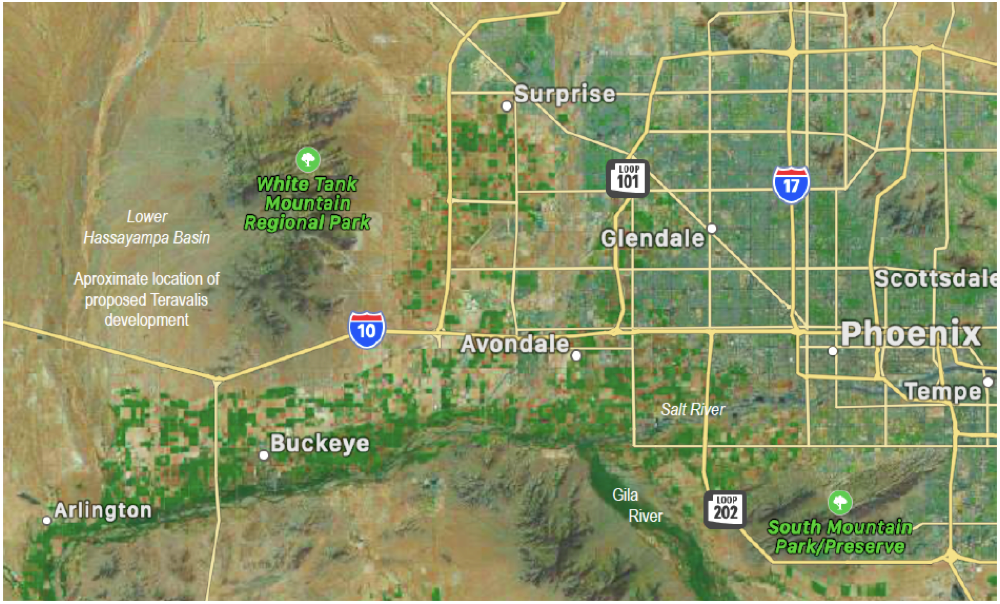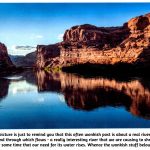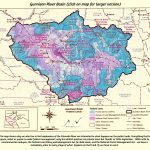
There’s a bit of a lull in the multiple conversations up and down the Colorado River Basin, with some positions staked out, while the Bureau of Reclamation initiates an ‘emergency environmental impact statement’ to ascertain, supposedly by late summer, what resolution it will either accept from the seven Basin states, or impose on the states, to reduce consumptive use throughout the Basin by two million acre-feet or more.
All of this is of course being covered in the mainstream media as a ‘water war,’ in their constant efforts to pump any cultural exchange up to a ‘let’s you and him fight’ situation. To call cultural negotiations a ‘war,’ even noisy negotitions among parties with interests at stake, both trivializes the terrible nature of ‘war’ and casts the exchange in an often exaggerated aspect of belligerent violence.
If you want to read about a Colorado River water war – fictional of course – pick up a copy of The Water Knife by Paolo Bacigalupe. Or if you like the comic opera version of a Colorado River water war, find an account of the 1934 incident when Arizona’s governor called out the Arizona National Guard to go occupy the site where California was beginning construction of Parker Dam and its Colorado River Aqueduct. Once you’ve got that warlust out of your system, come back to where the seven states and the feds are working on negotiated solutions, to avoid war.
Meanwhile, back in Central Arizona…. In my January 4 post on this site, I wrote about one of my favorite tributaries of the Colorado River, ‘the fabled Hassayampa’ in central Arizona, the waters of which, according to desert writer Mary Austin, will cause anyone who drinks to ‘no more see fact as naked fact, but all radiant with the color of romance.’
I opined much earlier here that there were probably more Colorado River tributaries than just that one which had that effect on those drinking from them, as evidenced by the extent to which the naked facts have obviously been left shivering in the dark as the development and management of the entire river has galloped along on the winged steeds of a romantic optimism. A romantic optimism that 6,000 years of both history and prehistory suggest should probably be taken carefully into the desert regions of the world, if at all – as, yes, Major John Wesley Powell tried to say 130 years ago, before he was booed off the stage at an Irrigation Congress pep rally around the turn of the century.
The earlier post was about the fact that the lower Hassayampa River Basin has been in the news as the site of a yet another proposed major new real estate development, Teravalis, in the desert west of Phoenix. If built out, Teravalis would add another 300,000 people to the 5 million already in the Phoenix metropolitan area. It would be competing with an already booming development just to its south in the same basin, the city of Buckeye (see its billboard above), which has gone from a farm village of 6,500 in 2000 to over 100,000 today. Here’s a map that gives you the general lay of the land in the Phoenix area:

The Hassayampa River bed is at the far left, north to south, with no surface flow; a small desert river keeps most of its water underground in the sand, gravel and cobble that protect it from the desert sun. The larger Salt River runs right to left through Phoenix, to its confluence lower center with the Gila River coming up from the south. The proposed Teravalis development lies just west (left) of the White Tank Mountains in the lower Hassayampa Basin. All the little green squares there are agricultural land, mostly irrigated now from groundwater.
But, as noted in the earlier post, Teravalis is temporarily on hold until it can prove that it controls enough water for a 100-year supply, most of which would be groundwater from the Hassayampa Aquifer. At that time, the Arizona Department of Water Resources was reportedly conducting a study of the aquifer, the results of which would also impact the future growth of Buckeye.
As it turns out, that study was already completed, last year! But then-Governor Doug Ducey decided not to release it, apparently under T.S. Eliot’s caution that ‘human kind cannot bear very much reality.’ The new governor Katie Hobbs has released the report, which concludes that, if the proposed development in the west valleys occurs, there will be a cumulative shortfall near the end of the hundred years of more than four million acre-feet of water.
‘I just think there was a lack of real honesty with the people of Arizona about the
situation we’re in,’ Governor Hobbs said in an interview for a National Public Radio story. But at the same time, she said she doesn’t think it is necessary at this point to put the brakes on future development. ‘I think if we don’t really address
these issues head on, look at the reality of the situation with water, look at how quickly
we’re growing, then we will get to that point.’
This is, recall, part of the water supply in a river system whose managers have said at least two million acre-feet in consumptive use have to be cut in the very near future to save the water supply, which drives farmers and cities alike to pumping more groundwater from aquifers, with less renewable water to recharge the aquifers. When groundwater is pumped from an aquifer and not recharged fairly quickly, the ground begins to compress and close up the often tiny spaces from which the water has been drawn; the surface subsides, and the rechargable part of the aquifer disappears, generally forever. Parts of the Salt-Gila river system have already experienced subsidence of a dozen feet or so.
We should also note that a ‘100-year water supply’ depending mostly on groundwater is not necessarily a ‘renewable water supply.’ If the recharge rate is less than the withdrawal rate, it is still water-mining.
But the developers are relatively unfazed by the report. Buckeye Mayor Eric Orsborn, who also owns a construction company, told NPR that the report will help his city in its future water planning. Construction can continue now because the existing development has proved its 100-year supply. And for other developers: ‘I don’t think we want to shut off all of the growth trying to figure out the solution for
all the growth. We can do this in an incremental approach.’
The plan to increase the water supplies is basically to go out into the region and look for water to import from other basins. The 100-year rule only applies in the metropolitan corridor; in ‘rural’ Arizona there are still no limits on groundwater pumping. At the extreme, there has been talk of building a big desalinization plant in Mexico and piping the water to Central Arizona – a fantastically expensive idea with current technology. But this is now, that will be then, and who knows what might be possible then? The beat goes on.
The developers, realtors, construction companies and community boosters that make up the growth economy of the Southwest say, of course, that the people are coming, so we have to keep on building for them; we can’t just shut them all out because we aren’t certain how much water we’ll have a hundred years down the road! That the people will keep on coming is undoubtedly true to some extent, but – do we have to keep luring them into the desert with promises of green oases? Looking at Buckeye’s billboard at the beginning of this post, should we maybe consider some ‘truth in advertising’ measures?
For example: how about making the entire growth industry, realtors to builders, do what tobacco purveyors have to do now. Make them put on billboards, brochures and advertisements like Buckeye’s, in letters large enough to read with the naked eye, warnings like these:
SITTING OUTSIDE ON THE LAWN IN XX% OF PHOENIX’S SUMMER DAYS
WILL KILL YOU IN X HOURS FROM EXTREME HEAT
or
LAWNS LIKE THE ONE PICTURED ARE NOW ILLEGAL FOR RESIDENCES
or
THIS IS A DESERT WITH STRESSED ENERGY RESOURCES,
AND YOU MIGHT DIE HERE IF AIR CONDITIONING FAILS
Just a thought. Next post, we’ll take a gingerly look at appropriation law, and muse on how, or if, it can still function in a situation where there’s nothing left to appropriate.




This whole continuing development thing is pretty hard to grasp. Everyone knows there is not enough water. But some arbitrary standards are established that pretend there is enough water and then all arguments focus on the fiction as the determing factor for further developing or not developing. The argument that people are coming so we have to accomodate them is beyond absurd. It should be a requirement of every new import to Arizona, or any of the 7 States, to bring your own water sufficient for 100 years. Sometimes the only defense against absurdity is absurdity. What happened to the “No Vacancy” sign.
‘Sometimes the only defense against absurdity is absurdity’ – I like that.
I’m experiencing whiplash! Just finished reading more about winters at the biological center next to Gothic mountain at the headwaters of the river that supplies water to Buckeye, Arizona, and it gives me a brain cramp contemplating how we concocted such a dilemma and how we might solve it by other than through bellicose strategies. Thanks for the mind benders!
You’re welcome, Carl – Minds that bend don’t break….
Nicely done, as usual. The names don’t really fit together, of course: Buckeye conjures visions of rugged cowboys atop their long-suffering horses, which get an occasional drink from the cowboy’s proffered Stetson (at least that’s what the artwork on the satin lining of my own Stetson shows), while Teravalis sounds so verdant and lush and environmentally pure, neither vision having much to do with reality “on the ground” as you like to say.
To what you’ve already said I would only add an idea I still remember from multiple conversations with Dick Lamm: “Trying to plan farther out than your grandchildren is probably futile.” Developers, at least the ones I’ve encountered, think more in terms of quarterly earnings reports or units sold. A century in the future might as well be a millennium, or a geologic era like the paleolithic. They have bills to pay, profits to make, etc., and if it all falls apart a decade after they die, well, they’ll be dead, and won’t have to deal with the consequences of emptying out that aquifer so the new desert community can keep its golf course well-watered.
Meanwhile, here in Minneapolis, in the land where winter never ends, I’m looking out at 8 inches of snow on the ground, with several more inches predicted to fall by week’s end. It’s water that someone in a corporate office somewhere would like to pump from here to metro Phoenix, just to keep the growth going. As is often the case, I’m reminded that unrestrained growth in a medical context is called “cancer.”
Nice! Gets right at the heart of the problem —- mindless growth
I quote from Buckeye’s Mayor Orsborn’s comment, “”We can do this in an incremental approach.” Wow! A typical politicians solution based on “Kicking the can down the road”, for someone else to solve.
Hi George,
The warnings you suggest posting for future Arizona residents aren’t exaggerated!
Enjoyed your map and explanation of sources and problems of water sufficiency in greater Phoenix area too.
Paula
I started to write something like: “You would think that the mayor of a town right in the path of what amounts to something like Sherman’s flaming march through Georgia (or someplace down there or somebody) would not “lead” his constituents into that path if he could avoid it,” but I decided not to write something like that and just think hey, I’m glad I don’t live in or near Buckeye, or anyplace else in that vicinity. Of course, I suppose it must be said in all fairness–say what!–that the mayor of Buckeye isn’t exactly recruiting me either.
I think the mayor of Buckeye is recruiting everyone who gets tired of shoveling snow….
We can only wish to see billboards like this.
Narcissa